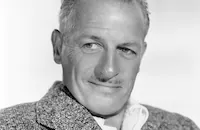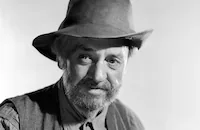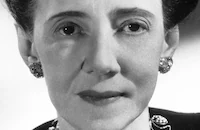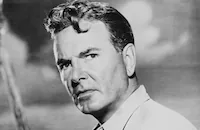It happens again in Bulldog Drummond's Peril, and this time the interruption is closely connected with the impending nuptials, since someone slays the police officer who's safeguarding the wedding gifts in Phyllis's fabulous Swiss chateau. The most exotic of the presents is a large synthetic diamond cooked up by Professor Bernard Goodman with a revolutionary new method known to nobody but him. The professor doesn't want to profit from the process; his dream is only to unveil his discovery at the next meeting of the Royal Society for the edification of his fellow scientists. Now his prime exhibit has been snatched by whoever killed the policeman, and before long Professor Goodman is snatched as well. Captain Hugh must crack the puzzling case before the chemical wizard meets further harm, and marriage to Phyllis will have to wait. For the umpteenth time plus one.
The screen adventures of Bulldog Drummond are based on a long-lived book series by Herman C. McNeile, best known by the pseudonym Sapper, since as a British Army officer he wasn't allowed to publish under his own name. Drummond made his screen debut in a British silent movie of 1922, based on one of three stage plays Sapper wrote about him in addition to almost a dozen novels. When detective films got a major boost from the advent of sound cinema, Bulldog's voice rang out in a 1929 picture starring suave Ronald Colman, who earned an Academy Award nomination for his portrayal.
Bulldog Drummond's Peril premiered in 1938, when Paramount's series - not to be confused with Drummond pictures made by British studios, and later by other Hollywood outfits - was in its prime. The plot comes from The Third Round, which is (logically enough) the third of Sapper's many Drummond novels. That book had already been the source of Bulldog's second silent movie, a 1925 release starring Jack Buchanan as the ace investigator.
Paramount's adaptation, directed by series regular James Hogan, surrounds Howard with supporting players who crop up frequently in Drummond films. This is the second of three for John Barrymore, who gets top billing as Colonel Neilson, the Scotland Yard inspector who's not quite as sharp as his private-eye counterpart. Louise Campbell plays Phyllis, a role Heather Angel has in some other installments. The reliable Reginald Denny plays Bulldog's best pal, Algy Longworth, and smooth-as-silk E.E. Clive plays Tenny, the gentleman's gentleman who saves the day at a moment when all seems lost - and does it on a motorcycle, no less.
Although it follows the general plot of the novel, Bulldog Drummond's Peril takes major liberties with Bulldog himself, which is standard for movies with his name in the title. McNeile made him a big guy - six feet tall, nearly 200 pounds - with an uncouth appearance and a craving for new challenges to stave off boredom and exercise the skills he picked up during his World War I service. Bulkiness and uncouthness don't describe Howard or the other stars who've portrayed Drummond, but it's never surprising when studios add a few layers of glamour to a hero. While he's a sort of rough-and-ready James Fenimore Cooper frontiersman in McNeile's novels, he's an early edition of James Bond on the screen. Along similar lines, the film's rapid repartee is closer to Dashiell Hammett and The Thin Man than to the hardboiled dialogue of Raymond Chandler and Philip Marlowe.
Drummond's genius for sleuthing also gives him a touch of Sherlock Holmes, and just as Holmes has a brilliant archenemy in Professor Moriarty, the early McNeile novels pit Drummond against Carl Peterson, a fiendish foe who shares the detective's taste for intricate schemes with life-and-death stakes. The Third Round is one of the novels in McNeile's so-called Peterson Quartet, but in Bulldog Drummond's Peril the evil mastermind has a different name. Paramount presumably thought each Drummond spinoff should have a fresh villain for variety's sake.
Nobody refers to Bulldog as Bulldog in The Third Round, and in Bulldog Drummond's Peril it's the same. He confirms his right to the moniker, though, by keeping a tenacious grip on the hunt for the abducted scientist, whose kidnaper wants the secret formula as a tool for extorting vast payments from the international diamond industry, which would be ruined if undetectable artificial gems suddenly flooded the market. Stuart Palmer's screenplay makes good use of cloak-and-dagger impersonations - at one point a character pulls a fast one by pretending to be disguised as himself - and the diamond-making lab has delicious echoes of the mad-scientist setup in James Whale's original Frankenstein, released just seven years earlier. The story moves along vigorously thanks to no-nonsense directing by Hogan and crisp, efficient editing by Edward Dmytryk, who moved on to a major directing career soon afterward.
Bulldog Drummond's Peril is no masterpiece of the genre, and it's hard to forgive the filmmakers for shoehorning a cutesy little penguin - where did that idea come from?! - into the action. Fans of vintage thrillers will find much to enjoy, though, and fans of the Bulldog will find even more.
Director: James Hogan
Screenplay: Stuart Palmer; based on The Third Round by Herman C. McNeile, aka Sapper
Cinematographer: Harry Fischbeck
Film Editing: Edward Dmytryk
Art Direction: Hans Dreier, Robert Odell
With: John Barrymore (Colonel Neilson), John Howard (Hugh "Bulldog" Drummond), Louise Campbell (Phyllis Clavering), Reginald Denny (Algy Longworth), E.E. Clive (Tenny), Porter Hall (Dr. Botulian), Elizabeth Patterson (Aunt Blanche), Nydia Westman (Gwen Longworth), Michael Brooke (Anthony Greer), Halliwell Hobbes (Professor Bernard Goodman), Matthew Boulton (Sir Raymond Blantyre), Zeffie Tilbury (Mrs. Weevens), David Clyde (Constable McThane), Clyde Cook (Constable Sacker), Austin Fairman (Roberts)
BW-66m.
by David Sterritt

























